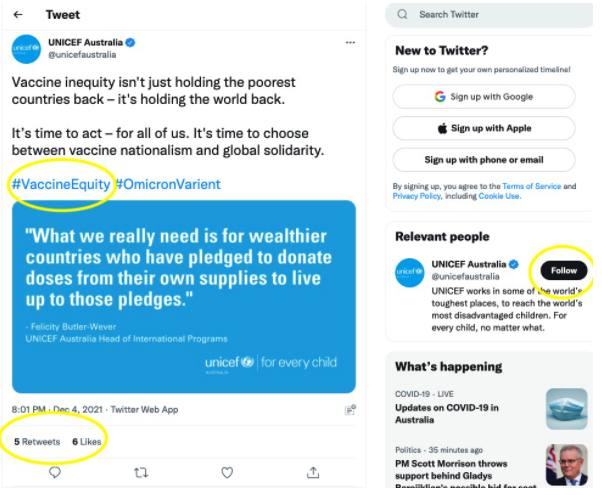For many supporters and potential supporters, social media is not just part of their social life, it is integral to their work, engagement with communities, politics, news and personal development.
As a charity, to leverage the power of social media, you need know your supporters and your organisation’s strategy well and be able to connect the two.
If you are new to social media, explore our getting started on social media guide. If you are becoming familiar with the power of social media and are now looking to take it to the next level, this guide is for you.
Create a social media strategy
Social media marketing is a part of a company’s marketing strategy, and one cannot replace the other. Make sure you are clear on what you would like to use social media for as part of your wider marketing activities, then create a specific social media strategy which defines which channels you will use, how and why.
1. Establish the overarching purpose
What would you like to achieve by using social media? Establish whether your primary purpose is fundraising, to petition to your advocates, to build a volunteer community or something else.
2. Establish your audience
See our tips on understanding who your audience is and what their needs are in our guide to building an integrated communications plan. Which social media channels do most of your existing supporters use? Direct your efforts to where they are, and then direct them to your own sites.
Probono have published some statistics on the percentage of Australian adults who are on each platform:
- Facebook 94 per cent
- Instagram 46 per cent
- Snapchat 40 per cent
- Twitter 32 per cent
- Linkedin 18 per cent
- Pinterest 10 per cent
- Google+ 10 per cent
3. Competitor analysis
Why should a supporter engage with your presence rather than another organisation? Facebook lets you see other organisations' ads here and its worth taking time to study the content and activity of similar organisations. What can you learn from them and what is your point of difference?
4. Decide which social media platforms you will use
Our advice is to start with one platform and do it well, then you can build out a presence on others as you learn and understand what works for your audience.
- Use Facebook “Groups” to build communities. For example, a community neighbourhood centre may create a closed group to enable the community to support each other. The organisation might moderate the group and add content such as useful local resources and events.
- Use Facebook “Giving” to create a fundraising campaign. The most money ever raised through this channel was via the NSW bushfire appeal in 2020. Key components were: urgency, simple messaging, compelling visuals easily shared and strong engagement (comments and sharing) by large numbers of people. Started by a local celebrity, Celeste Barber, it was catapulted internationally by her large following. You may not have such a large following, especially at the start, but by creating compelling, shareable content that speaks to your audience you will start to build one.
- Use Facebook quiz/polls/petition for advocacy. This is a good tool to stimulate engagement with a question that hooks into people’s desire to compete or to see where they rank compared to others. It can be light-hearted with a serious underlying message if you wish.
X (formerly known as Twitter)
This is the place where status updates are short and sweet, and hashtags can help you connect and share locally or internationally very quickly. Conversations on X are the route to developing and participating in communities.
It has been used to great effect by not-for-profits to raise awareness for a particular campaign by creating a hashtag that is picked up or retweeted by other organisations or individuals with a very large following. Here is an example tweet from Unicef about vaccine equity:

LinkedIn is a social media platform designed to help grow connections between individuals and businesses.
It could be used by not-for-profits to garner support from corporates or other organisations, to build a community of like-minded people and to reach individuals who interact with LinkedIn in a professional context and may share relevant content.
Instagram has been used by organisations to leverage a younger audience. Using "reels" or "stories" can really capture the essence of your organisation or campaign and help you connect with your audience.
Raise Foundation are trialing different images and calls to action and content types on their page to engage their supporters.
Tiktok and other, newer social media platforms
Newer social media platforms such as TikTok are advanced tools. If you are still testing and learning with more established platforms, wait until you have the basics humming on those. You will also need a greater capacity to generate engaging content for the active audience of TikToK.
New platforms are continually launching and existing ones are constantly evolving and refining so we encourage you to keep your eyes and ears open for what is new and could be a good fit for your organisation.
5. Establish your business goals for each social media platform
Once you have decided which platforms to focus on, establish exactly what you want to achieve with each. It could be used to:
- build relationships with customers through engaging conversations to increase their connection to your brand
- drive visitors to your website
- save money on print advertising
- any other goal to help your organisation achieve its strategy
6. Establish your audience
If you don't know who you're talking to, then you're not talking to anyone in particular. Understanding your audience and their demographics and avatars will determine your social media strategy, so don't miss this component. You can find a valuable webinar on this topic and how you can use the magic of AI to do this for you here.
7. Establish your objective for each goal
- For example, if your goal for Instagram is to drive donations on your website, create an objective for the number of donations that will be driven from your Instagram posts.
- Other examples of objectives include number of comments, downloads of an e-book or number of people signing a petition.
Example social media strategy template
Now you have decided which platform(s) to use, who you will be talking to and why you will use each one, write down your plan to create alignment with colleagues and to ensure you stay on track.
An example of a high-level social media strategy for an organisation that offers financial support to parents of young children with cancer could be:
| Platform | Audience | Business goal | Objective |
| Working parents aged 30-45 | Increase numbers of supporters | Increase number "liking" page by 100 per month for 3 months |
Download our social media strategy template (Word doc)
Define your budget and time allowance
You will need to consider and plan for costs, which may limit the number of platforms you use, or what you will do with each.
- Using strong visuals will ensure much greater engagement, but content creation, for example photographic and video development, are not cheap.
- Paid ads. These are worth doing, especially if you're still building your following and want to reach people outside of your usual supporter-base.
- In-house labour, including content management, moderation and technical support can all be costly.
Build upon your strategy
Once you have your high-level strategy, you will want to get into detail now and include:
- Creative direction
What is the look and feel, what is the messaging in your posts? See our guide to creating multimedia on a budget. - Content publishing calendar
Create a schedule for when you will release each piece of content, how long it will remain for and who will be responsible. Trello, Canva and Asana have created templates to support your scheduling. - Community management practices
Decide who will moderate comments and what your guidelines will be about what content would be tolerated and in which scenarios you would delete content or ban users, for example.
Actively maintain your presence
Use a measurement platform to constantly assess the value of your presence, test and learn and evolve to make sure the platforms you have chosen are helping to achieve your goals. This will help you to make sure what you are doing is working and supports the overarching goals of your organisation.
Social media is a fantastic way to engage with your communities and share knowledge and increase your presence. Utilising it in the most efficient way for your organisation will ensure you are engaging your audiences and sharing your purpose
Read more about evaluating your online presence
Learn more about social media by participating in a digital marketing training course.





Status message
Thanks for rating this guide.